An Evaluation of the Working Memory Model in Cognitive Psychology
VerifiedAdded on 2022/12/29
|8
|2036
|20
Essay
AI Summary
This essay provides a comprehensive overview of the working memory model, originally proposed by Baddeley and Hitch. It delves into the model's core components, including the central executive, phonological loop, visuospatial sketchpad, and the later addition of the episodic buffer. The essay explains the functions of each component and their roles in processing and storing information. Furthermore, it critically evaluates the model by examining its strengths, such as its ability to explain dual-task performance and account for deficits observed in patients with brain damage, like KF. The essay also discusses the weaknesses of the model, including criticisms regarding the central executive and the lack of direct evidence for the capacity of the central executive. Finally, the essay synthesizes these points to provide a balanced assessment of the working memory model's contributions to understanding human memory and cognition, supported by research findings and case studies. The essay also discusses the impact of the working memory model on real-life tasks like problem-solving and navigation.
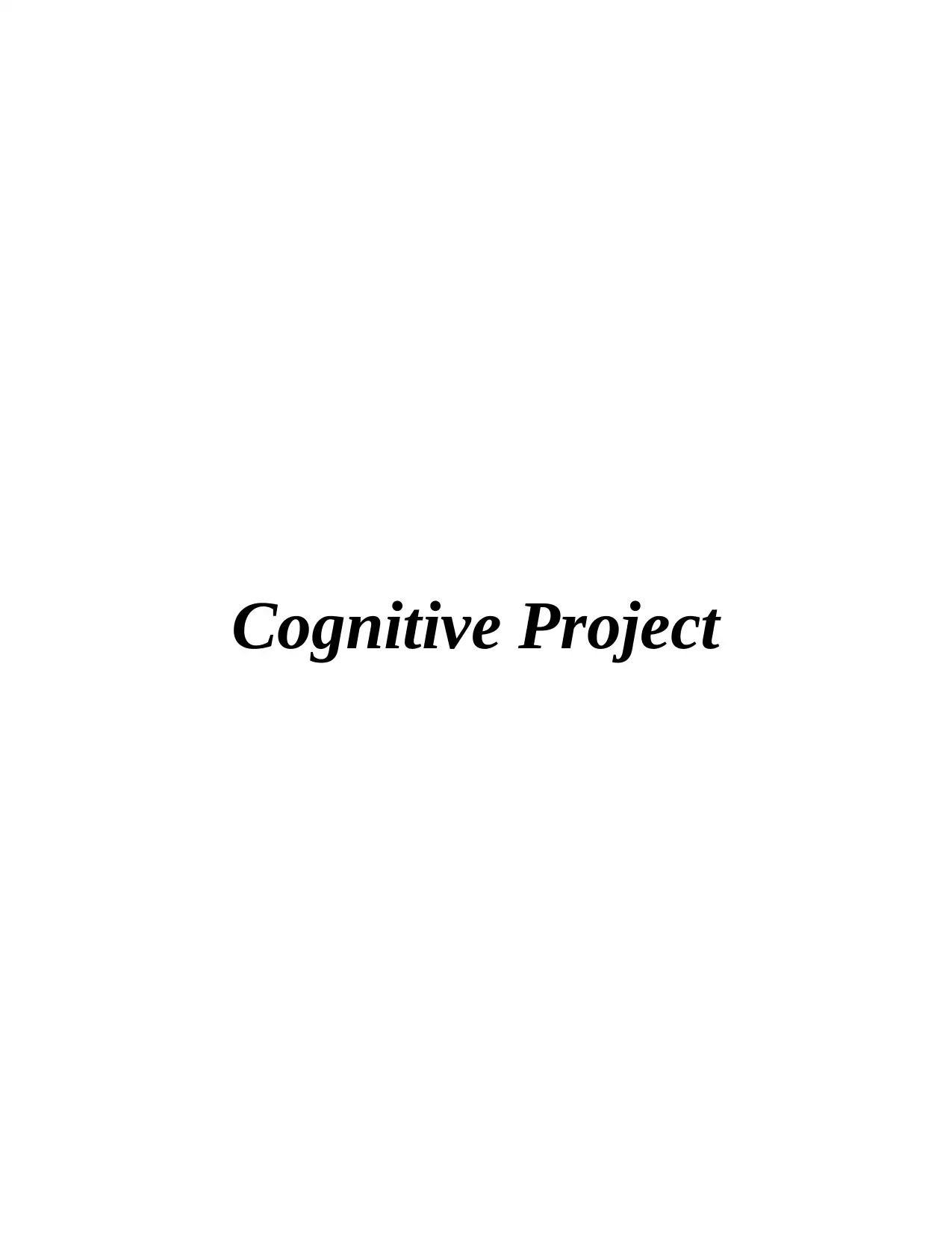
Cognitive Project
Paraphrase This Document
Need a fresh take? Get an instant paraphrase of this document with our AI Paraphraser

Table of Contents
INTRODUCTION...........................................................................................................................3
MAIN BODY...................................................................................................................................3
Overview of the working memory model...................................................................................3
Critical evaluation of working memory model...........................................................................6
CONCLUSION................................................................................................................................7
REFERENCES................................................................................................................................8
INTRODUCTION...........................................................................................................................3
MAIN BODY...................................................................................................................................3
Overview of the working memory model...................................................................................3
Critical evaluation of working memory model...........................................................................6
CONCLUSION................................................................................................................................7
REFERENCES................................................................................................................................8

INTRODUCTION
Memory is the ability which actually help in retain and recollect the past experience of
the person in order to use that experience for the future prospects. There are the two type of
memory which is used implicit and explicit memory (Murray, Jaramillo and Wang, 2017) .
These memories are helpful in memorising the past events, reading, writing, speaking and
communicating, understanding the concepts and recognizing the concepts. In this essay multi
store model of memory is explained which is given by Atkinson and Shiffin in 1968. This
memory is three parts including sensory store, short term memory and long term memory. This
model is very useful for the people who are facing short term memory loss problem. The
memory of the person is influenced by the encoding process, storage process and retrieval
process in which how the information is accessed easily is used. In the essay the relevant theory
and there strength and weakness are explained with specified examples.
MAIN BODY
Overview of the working memory model
Atkinson and Shiffrin developed a model in 1968, named multi stored model, this model
is extremely successful in term of the point where the research is generated. It is a application
which is used for developing the ideas concerning the characteristics of the short term memory
people. But in 1974, Baddeley and Hitch argue and criticise that the picture of the above
discussed model is too simple for getting an access on the application.
According to Saul McLeod, the multi stored memory model, Short term memory hold the
limited information for the short period of time with comparing to others at less processing
power (Working Memory Model, 2012). It is the unitary system which means it is a single
system without having the subsystem. Short term memory model hold the information whereas
working memory model hold the information and process the information at the same time
(Persiani, Franchi and Gini, 2018). It is said that working memory model is the short term
memory model where information is stored in the different stores.
There are mainly three component of this model the first one is the central executive; this
component is responsible for monitoring and coordinating the functions and operations of
visuospatial sketchpad and phonological loop and further relate to the long term memory of the
individual aspect. The central executive system decide which part of working is more important
Memory is the ability which actually help in retain and recollect the past experience of
the person in order to use that experience for the future prospects. There are the two type of
memory which is used implicit and explicit memory (Murray, Jaramillo and Wang, 2017) .
These memories are helpful in memorising the past events, reading, writing, speaking and
communicating, understanding the concepts and recognizing the concepts. In this essay multi
store model of memory is explained which is given by Atkinson and Shiffin in 1968. This
memory is three parts including sensory store, short term memory and long term memory. This
model is very useful for the people who are facing short term memory loss problem. The
memory of the person is influenced by the encoding process, storage process and retrieval
process in which how the information is accessed easily is used. In the essay the relevant theory
and there strength and weakness are explained with specified examples.
MAIN BODY
Overview of the working memory model
Atkinson and Shiffrin developed a model in 1968, named multi stored model, this model
is extremely successful in term of the point where the research is generated. It is a application
which is used for developing the ideas concerning the characteristics of the short term memory
people. But in 1974, Baddeley and Hitch argue and criticise that the picture of the above
discussed model is too simple for getting an access on the application.
According to Saul McLeod, the multi stored memory model, Short term memory hold the
limited information for the short period of time with comparing to others at less processing
power (Working Memory Model, 2012). It is the unitary system which means it is a single
system without having the subsystem. Short term memory model hold the information whereas
working memory model hold the information and process the information at the same time
(Persiani, Franchi and Gini, 2018). It is said that working memory model is the short term
memory model where information is stored in the different stores.
There are mainly three component of this model the first one is the central executive; this
component is responsible for monitoring and coordinating the functions and operations of
visuospatial sketchpad and phonological loop and further relate to the long term memory of the
individual aspect. The central executive system decide which part of working is more important
⊘ This is a preview!⊘
Do you want full access?
Subscribe today to unlock all pages.

Trusted by 1+ million students worldwide
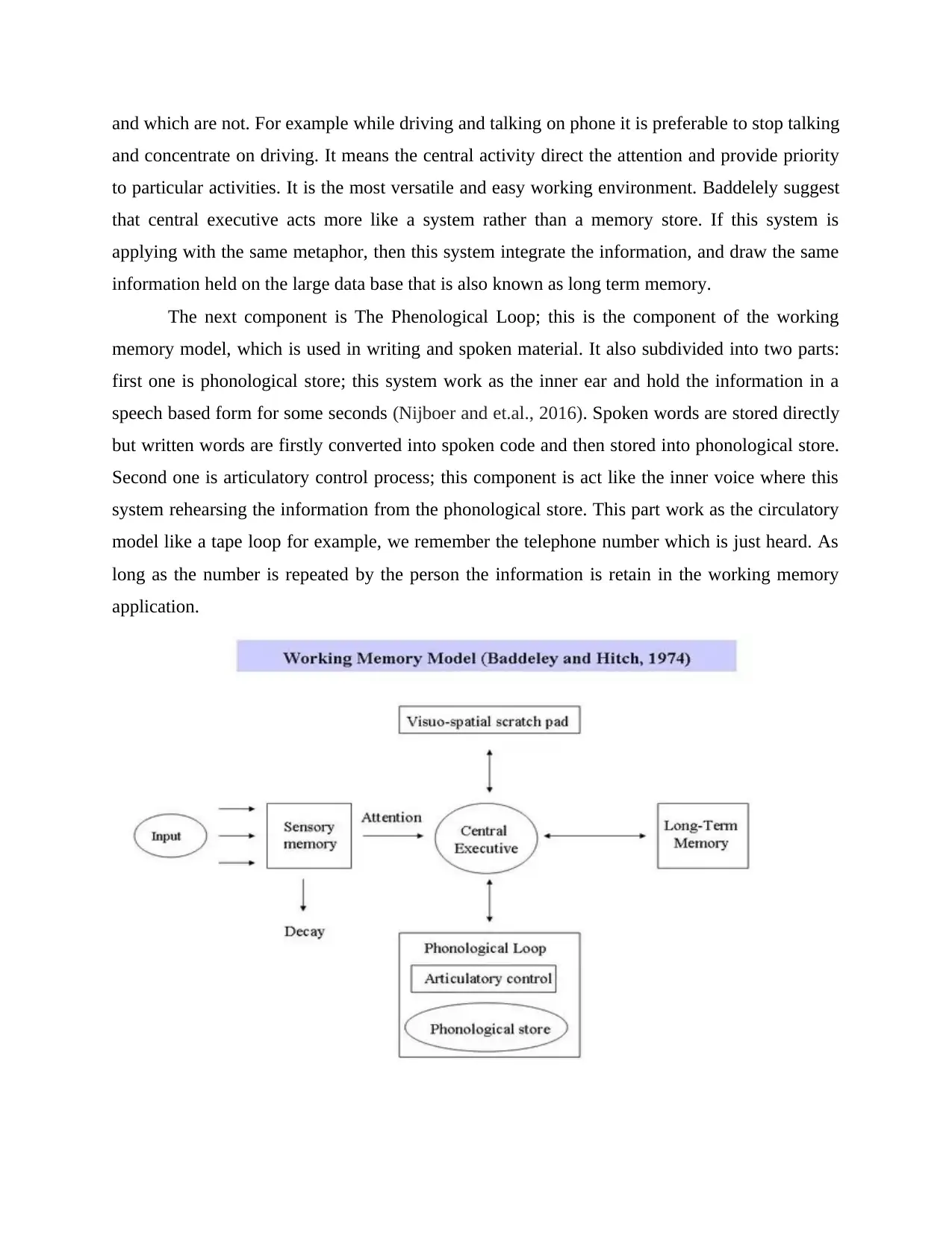
and which are not. For example while driving and talking on phone it is preferable to stop talking
and concentrate on driving. It means the central activity direct the attention and provide priority
to particular activities. It is the most versatile and easy working environment. Baddelely suggest
that central executive acts more like a system rather than a memory store. If this system is
applying with the same metaphor, then this system integrate the information, and draw the same
information held on the large data base that is also known as long term memory.
The next component is The Phenological Loop; this is the component of the working
memory model, which is used in writing and spoken material. It also subdivided into two parts:
first one is phonological store; this system work as the inner ear and hold the information in a
speech based form for some seconds (Nijboer and et.al., 2016). Spoken words are stored directly
but written words are firstly converted into spoken code and then stored into phonological store.
Second one is articulatory control process; this component is act like the inner voice where this
system rehearsing the information from the phonological store. This part work as the circulatory
model like a tape loop for example, we remember the telephone number which is just heard. As
long as the number is repeated by the person the information is retain in the working memory
application.
and concentrate on driving. It means the central activity direct the attention and provide priority
to particular activities. It is the most versatile and easy working environment. Baddelely suggest
that central executive acts more like a system rather than a memory store. If this system is
applying with the same metaphor, then this system integrate the information, and draw the same
information held on the large data base that is also known as long term memory.
The next component is The Phenological Loop; this is the component of the working
memory model, which is used in writing and spoken material. It also subdivided into two parts:
first one is phonological store; this system work as the inner ear and hold the information in a
speech based form for some seconds (Nijboer and et.al., 2016). Spoken words are stored directly
but written words are firstly converted into spoken code and then stored into phonological store.
Second one is articulatory control process; this component is act like the inner voice where this
system rehearsing the information from the phonological store. This part work as the circulatory
model like a tape loop for example, we remember the telephone number which is just heard. As
long as the number is repeated by the person the information is retain in the working memory
application.
Paraphrase This Document
Need a fresh take? Get an instant paraphrase of this document with our AI Paraphraser

The third component of this model is The Visuospatial sketchpad; this component is deal
with visual and spatial information of the memory. Visual means what the person is see and what
they actually think about the visual presence of the objects. It is play an important role in keep
tracking with the other objects and things in the environment. As the person is not stable at a
position, the keep changing environment must be updated with the information in the system.
The sketchpad system also help in displaying and manipulating the information that held in the
long term memory of the individual. For example a spatial layout of the individual's own house
is held the information in the long term memory (Logie, Belletier and Doherty, 2020). Research
show that the working memory is deal with the two different system and approaches which are
visual and verbal communication. These both task can be performed at the same time and can be
stored information in the working memory model. As it is very difficult to maintain the two
visual and verbal task at the same time so the model support with the help of phonological loop
and sketchpad that separate the task within working environment.
This working memory model is last updated by Baddelely in 2000, when the model fail to
explain the desired results of various experiment which is based on the individual research. In the
addition to this component was added to this model called episodic buffer(Adam and et.al.,
2015). This component is added as the backup of the information which is communicate with the
both long term memory and other component of the working memory.
with visual and spatial information of the memory. Visual means what the person is see and what
they actually think about the visual presence of the objects. It is play an important role in keep
tracking with the other objects and things in the environment. As the person is not stable at a
position, the keep changing environment must be updated with the information in the system.
The sketchpad system also help in displaying and manipulating the information that held in the
long term memory of the individual. For example a spatial layout of the individual's own house
is held the information in the long term memory (Logie, Belletier and Doherty, 2020). Research
show that the working memory is deal with the two different system and approaches which are
visual and verbal communication. These both task can be performed at the same time and can be
stored information in the working memory model. As it is very difficult to maintain the two
visual and verbal task at the same time so the model support with the help of phonological loop
and sketchpad that separate the task within working environment.
This working memory model is last updated by Baddelely in 2000, when the model fail to
explain the desired results of various experiment which is based on the individual research. In the
addition to this component was added to this model called episodic buffer(Adam and et.al.,
2015). This component is added as the backup of the information which is communicate with the
both long term memory and other component of the working memory.
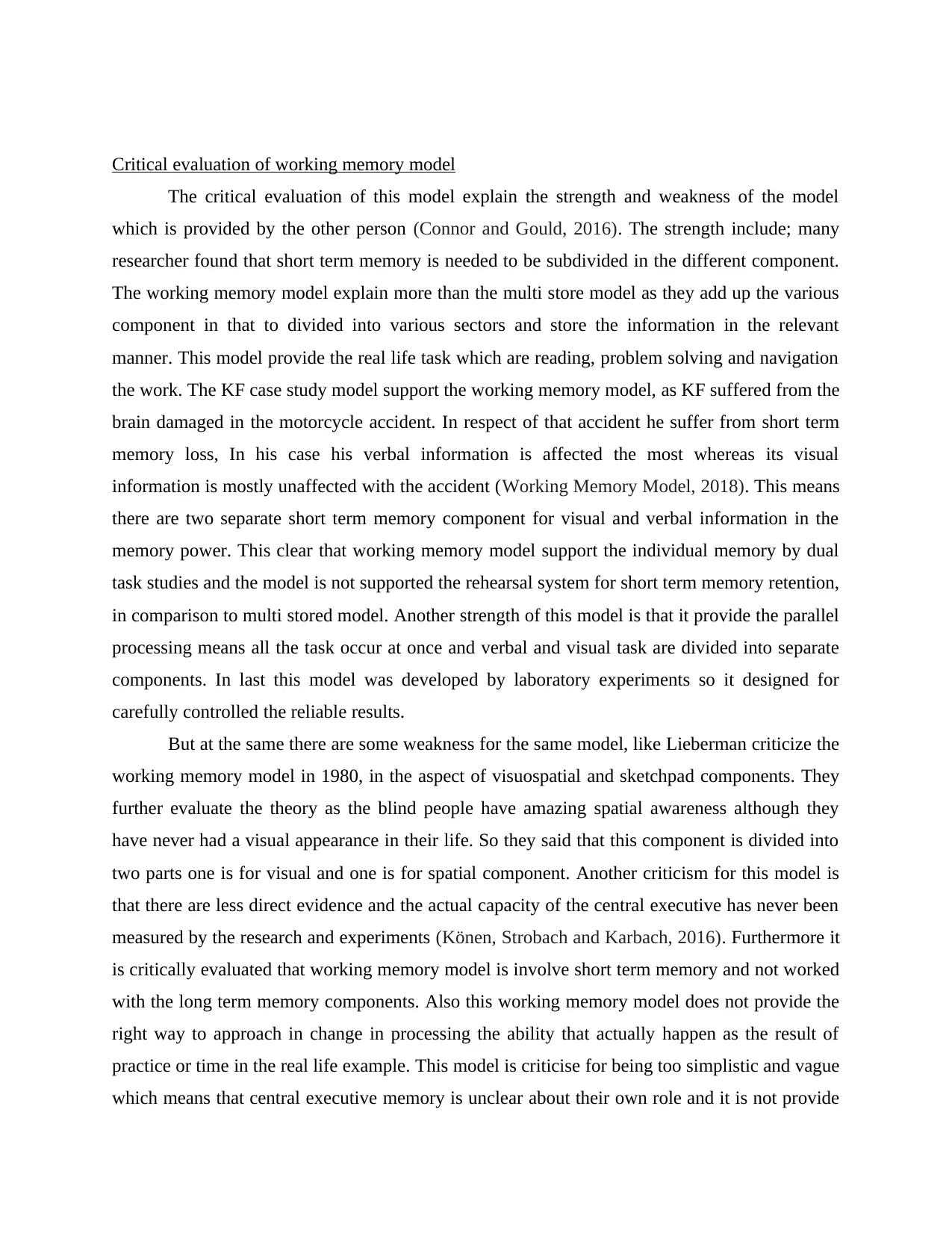
Critical evaluation of working memory model
The critical evaluation of this model explain the strength and weakness of the model
which is provided by the other person (Connor and Gould, 2016). The strength include; many
researcher found that short term memory is needed to be subdivided in the different component.
The working memory model explain more than the multi store model as they add up the various
component in that to divided into various sectors and store the information in the relevant
manner. This model provide the real life task which are reading, problem solving and navigation
the work. The KF case study model support the working memory model, as KF suffered from the
brain damaged in the motorcycle accident. In respect of that accident he suffer from short term
memory loss, In his case his verbal information is affected the most whereas its visual
information is mostly unaffected with the accident (Working Memory Model, 2018). This means
there are two separate short term memory component for visual and verbal information in the
memory power. This clear that working memory model support the individual memory by dual
task studies and the model is not supported the rehearsal system for short term memory retention,
in comparison to multi stored model. Another strength of this model is that it provide the parallel
processing means all the task occur at once and verbal and visual task are divided into separate
components. In last this model was developed by laboratory experiments so it designed for
carefully controlled the reliable results.
But at the same there are some weakness for the same model, like Lieberman criticize the
working memory model in 1980, in the aspect of visuospatial and sketchpad components. They
further evaluate the theory as the blind people have amazing spatial awareness although they
have never had a visual appearance in their life. So they said that this component is divided into
two parts one is for visual and one is for spatial component. Another criticism for this model is
that there are less direct evidence and the actual capacity of the central executive has never been
measured by the research and experiments (Könen, Strobach and Karbach, 2016). Furthermore it
is critically evaluated that working memory model is involve short term memory and not worked
with the long term memory components. Also this working memory model does not provide the
right way to approach in change in processing the ability that actually happen as the result of
practice or time in the real life example. This model is criticise for being too simplistic and vague
which means that central executive memory is unclear about their own role and it is not provide
The critical evaluation of this model explain the strength and weakness of the model
which is provided by the other person (Connor and Gould, 2016). The strength include; many
researcher found that short term memory is needed to be subdivided in the different component.
The working memory model explain more than the multi store model as they add up the various
component in that to divided into various sectors and store the information in the relevant
manner. This model provide the real life task which are reading, problem solving and navigation
the work. The KF case study model support the working memory model, as KF suffered from the
brain damaged in the motorcycle accident. In respect of that accident he suffer from short term
memory loss, In his case his verbal information is affected the most whereas its visual
information is mostly unaffected with the accident (Working Memory Model, 2018). This means
there are two separate short term memory component for visual and verbal information in the
memory power. This clear that working memory model support the individual memory by dual
task studies and the model is not supported the rehearsal system for short term memory retention,
in comparison to multi stored model. Another strength of this model is that it provide the parallel
processing means all the task occur at once and verbal and visual task are divided into separate
components. In last this model was developed by laboratory experiments so it designed for
carefully controlled the reliable results.
But at the same there are some weakness for the same model, like Lieberman criticize the
working memory model in 1980, in the aspect of visuospatial and sketchpad components. They
further evaluate the theory as the blind people have amazing spatial awareness although they
have never had a visual appearance in their life. So they said that this component is divided into
two parts one is for visual and one is for spatial component. Another criticism for this model is
that there are less direct evidence and the actual capacity of the central executive has never been
measured by the research and experiments (Könen, Strobach and Karbach, 2016). Furthermore it
is critically evaluated that working memory model is involve short term memory and not worked
with the long term memory components. Also this working memory model does not provide the
right way to approach in change in processing the ability that actually happen as the result of
practice or time in the real life example. This model is criticise for being too simplistic and vague
which means that central executive memory is unclear about their own role and it is not provide
⊘ This is a preview!⊘
Do you want full access?
Subscribe today to unlock all pages.

Trusted by 1+ million students worldwide
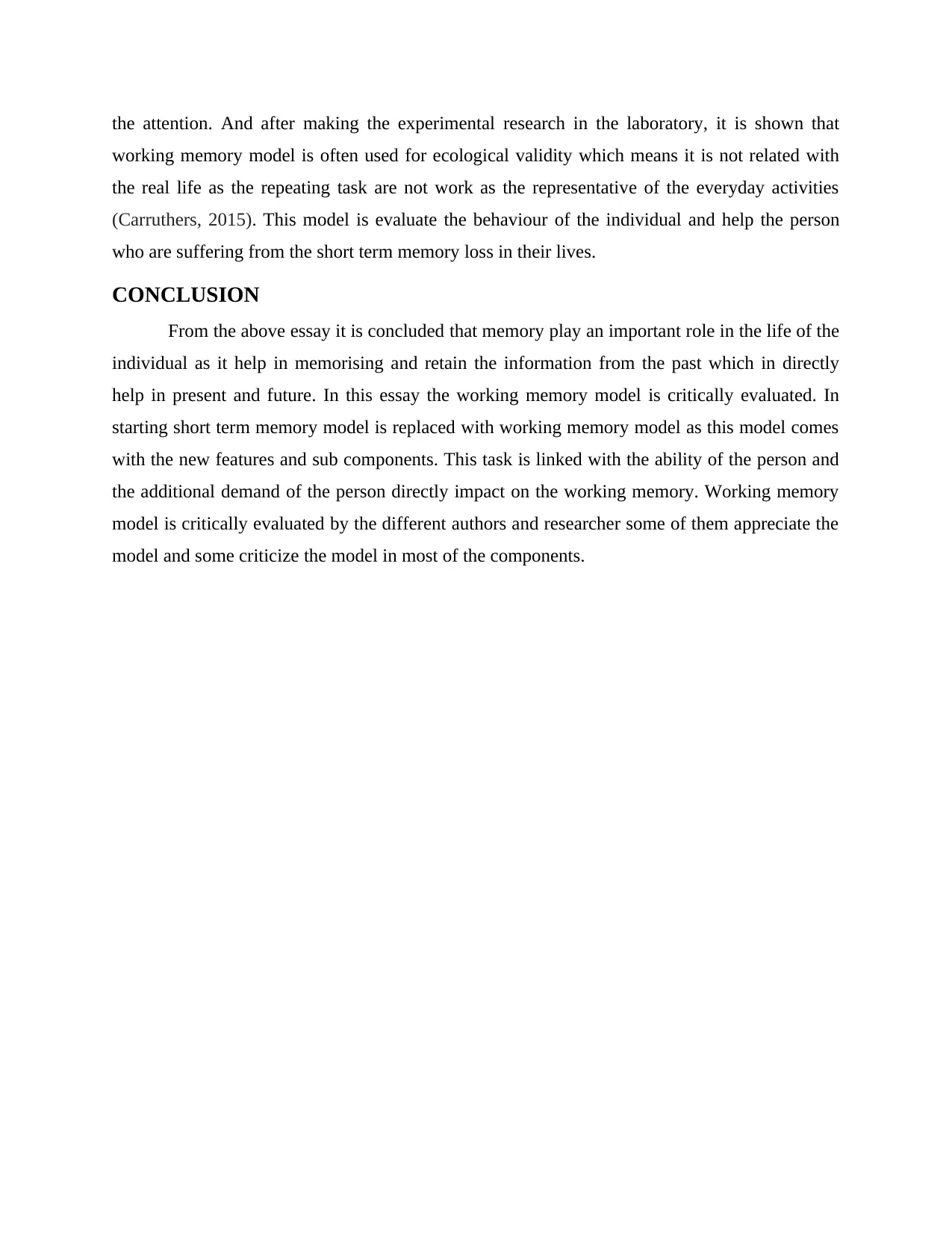
the attention. And after making the experimental research in the laboratory, it is shown that
working memory model is often used for ecological validity which means it is not related with
the real life as the repeating task are not work as the representative of the everyday activities
(Carruthers, 2015). This model is evaluate the behaviour of the individual and help the person
who are suffering from the short term memory loss in their lives.
CONCLUSION
From the above essay it is concluded that memory play an important role in the life of the
individual as it help in memorising and retain the information from the past which in directly
help in present and future. In this essay the working memory model is critically evaluated. In
starting short term memory model is replaced with working memory model as this model comes
with the new features and sub components. This task is linked with the ability of the person and
the additional demand of the person directly impact on the working memory. Working memory
model is critically evaluated by the different authors and researcher some of them appreciate the
model and some criticize the model in most of the components.
working memory model is often used for ecological validity which means it is not related with
the real life as the repeating task are not work as the representative of the everyday activities
(Carruthers, 2015). This model is evaluate the behaviour of the individual and help the person
who are suffering from the short term memory loss in their lives.
CONCLUSION
From the above essay it is concluded that memory play an important role in the life of the
individual as it help in memorising and retain the information from the past which in directly
help in present and future. In this essay the working memory model is critically evaluated. In
starting short term memory model is replaced with working memory model as this model comes
with the new features and sub components. This task is linked with the ability of the person and
the additional demand of the person directly impact on the working memory. Working memory
model is critically evaluated by the different authors and researcher some of them appreciate the
model and some criticize the model in most of the components.
Paraphrase This Document
Need a fresh take? Get an instant paraphrase of this document with our AI Paraphraser
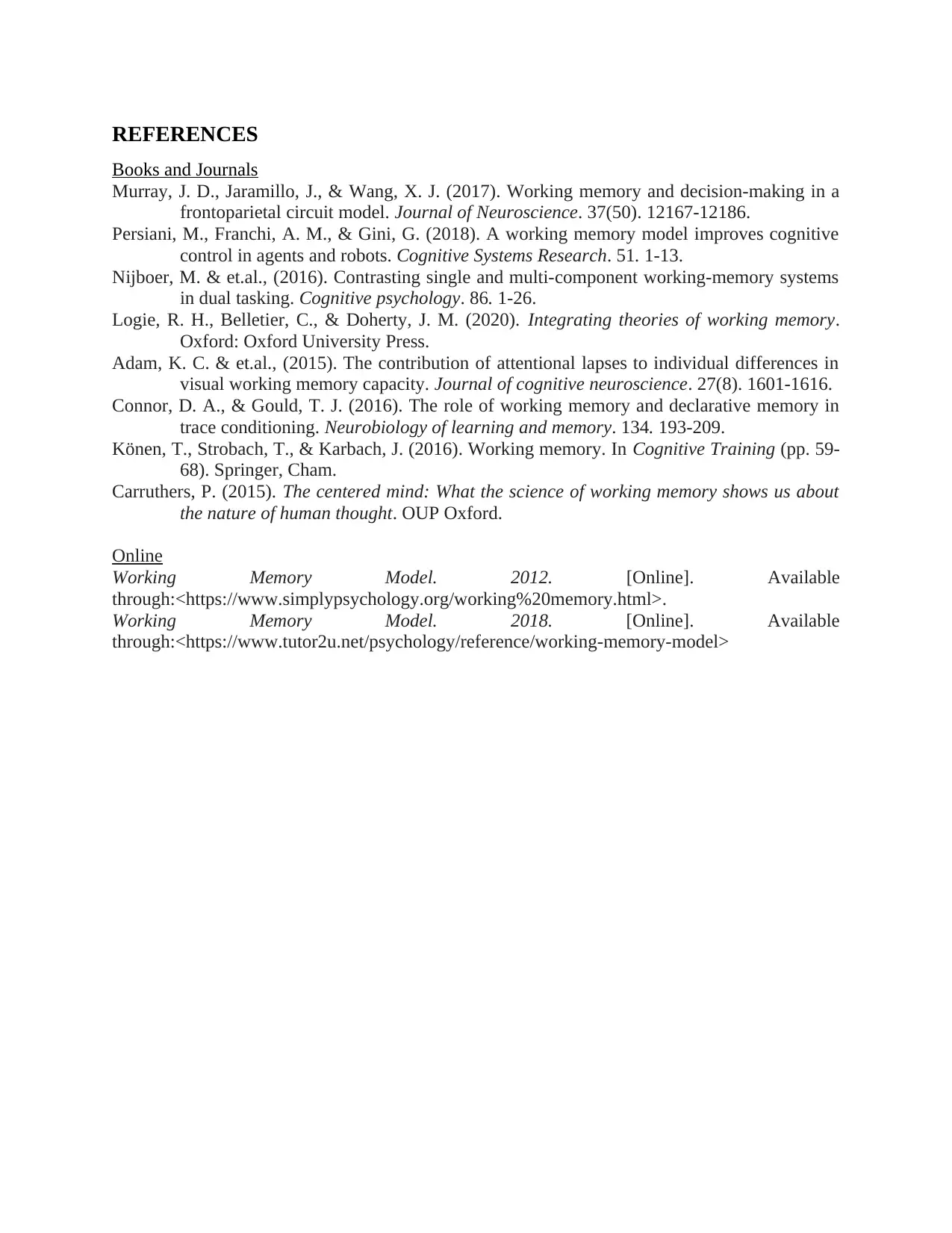
REFERENCES
Books and Journals
Murray, J. D., Jaramillo, J., & Wang, X. J. (2017). Working memory and decision-making in a
frontoparietal circuit model. Journal of Neuroscience. 37(50). 12167-12186.
Persiani, M., Franchi, A. M., & Gini, G. (2018). A working memory model improves cognitive
control in agents and robots. Cognitive Systems Research. 51. 1-13.
Nijboer, M. & et.al., (2016). Contrasting single and multi-component working-memory systems
in dual tasking. Cognitive psychology. 86. 1-26.
Logie, R. H., Belletier, C., & Doherty, J. M. (2020). Integrating theories of working memory.
Oxford: Oxford University Press.
Adam, K. C. & et.al., (2015). The contribution of attentional lapses to individual differences in
visual working memory capacity. Journal of cognitive neuroscience. 27(8). 1601-1616.
Connor, D. A., & Gould, T. J. (2016). The role of working memory and declarative memory in
trace conditioning. Neurobiology of learning and memory. 134. 193-209.
Könen, T., Strobach, T., & Karbach, J. (2016). Working memory. In Cognitive Training (pp. 59-
68). Springer, Cham.
Carruthers, P. (2015). The centered mind: What the science of working memory shows us about
the nature of human thought. OUP Oxford.
Online
Working Memory Model. 2012. [Online]. Available
through:<https://www.simplypsychology.org/working%20memory.html>.
Working Memory Model. 2018. [Online]. Available
through:<https://www.tutor2u.net/psychology/reference/working-memory-model>
Books and Journals
Murray, J. D., Jaramillo, J., & Wang, X. J. (2017). Working memory and decision-making in a
frontoparietal circuit model. Journal of Neuroscience. 37(50). 12167-12186.
Persiani, M., Franchi, A. M., & Gini, G. (2018). A working memory model improves cognitive
control in agents and robots. Cognitive Systems Research. 51. 1-13.
Nijboer, M. & et.al., (2016). Contrasting single and multi-component working-memory systems
in dual tasking. Cognitive psychology. 86. 1-26.
Logie, R. H., Belletier, C., & Doherty, J. M. (2020). Integrating theories of working memory.
Oxford: Oxford University Press.
Adam, K. C. & et.al., (2015). The contribution of attentional lapses to individual differences in
visual working memory capacity. Journal of cognitive neuroscience. 27(8). 1601-1616.
Connor, D. A., & Gould, T. J. (2016). The role of working memory and declarative memory in
trace conditioning. Neurobiology of learning and memory. 134. 193-209.
Könen, T., Strobach, T., & Karbach, J. (2016). Working memory. In Cognitive Training (pp. 59-
68). Springer, Cham.
Carruthers, P. (2015). The centered mind: What the science of working memory shows us about
the nature of human thought. OUP Oxford.
Online
Working Memory Model. 2012. [Online]. Available
through:<https://www.simplypsychology.org/working%20memory.html>.
Working Memory Model. 2018. [Online]. Available
through:<https://www.tutor2u.net/psychology/reference/working-memory-model>
1 out of 8
Related Documents
Your All-in-One AI-Powered Toolkit for Academic Success.
+13062052269
info@desklib.com
Available 24*7 on WhatsApp / Email
![[object Object]](/_next/static/media/star-bottom.7253800d.svg)
Unlock your academic potential
Copyright © 2020–2025 A2Z Services. All Rights Reserved. Developed and managed by ZUCOL.





